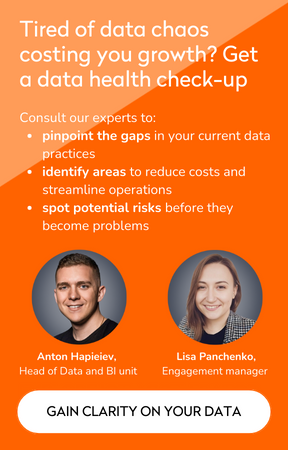
An enterprise data governance framework: Solve your biggest challenges with data security, quality, compliance
Summarize:
Handling messy data, security threats, and constantly changing compliance requirements isn’t only frustrating. It secretly hurts your enterprise’s growth and innovation.
You know you need to be “data-driven” — or whatever that trendy term for making decisions based on data may be — but how do you even start navigating this maze without getting lost?
You know every department and process relies on secure, trusted data readily available. Yet, with excessive data and limited resources, ensuring this security and accuracy sounds easier said than done.
Sounds familiar? Take a quick moment to check off any of these major data-related challenges:
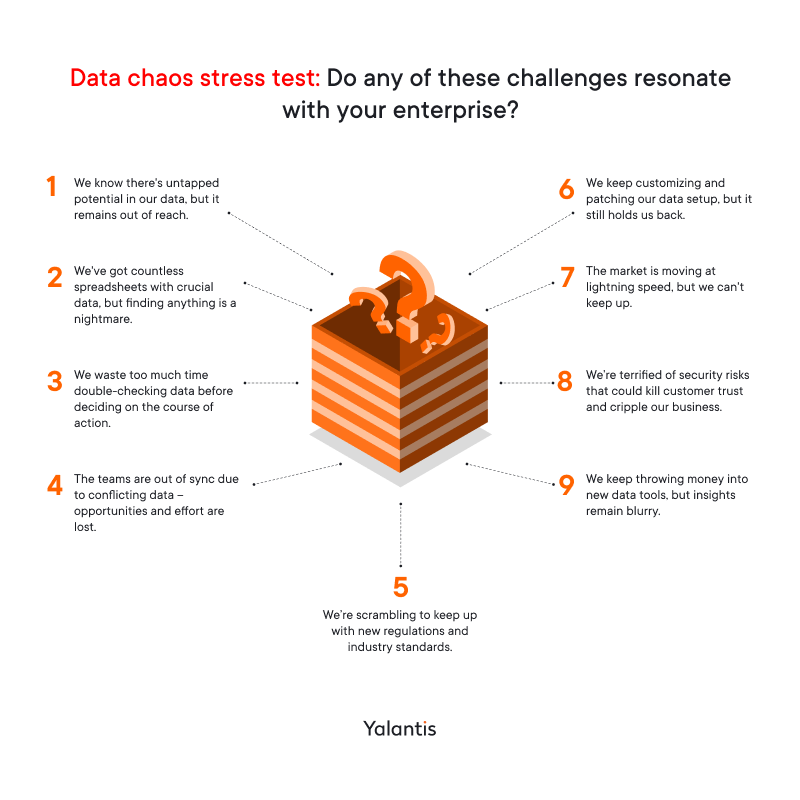
Trying to fix each problem one at a time can feel paralyzing. And even if you manage to solve some of these issues temporarily, what if there’s a deeper problem that keeps causing new challenges to appear?
If you’re facing any of these problems and want solutions, you’re in the right place. With our 15+ years of IT experience tackling data issues across industries, we’ll break down each major problem and guide you to a comprehensive fix. With it, you’ll be able to:
- make confident decisions based on data
- regain control of your data with improved compliance reporting
- find a balance between caution and innovation
- align your teams and improve collaboration by providing a quick and easy data access
- change how your company’s employees handle data, reducing costly errors and misuse
The four pillars of data chaos: See where your enterprise struggles the most
The data challenges you’re facing likely fall into four critical areas:
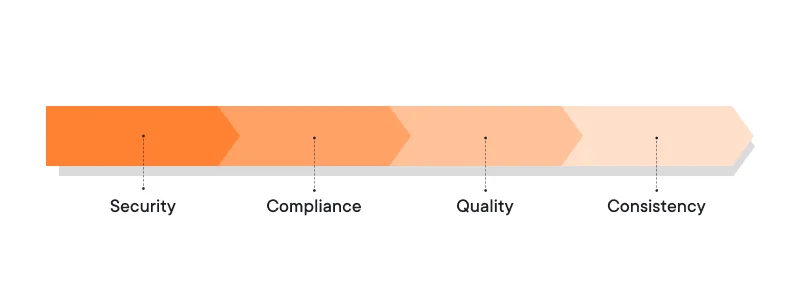
These areas may seem distinct, but tackling them individually is like patching a leaky roof — you fix one hole, and another springs open. This is where most companies struggle. In the meantime, addressing challenges holistically with a comprehensive data governance approach will save time, resources, and minimize future headaches (more on that later).
Read on to:
- learn about the modern limitations and risks companies face, supported by real-life numbers and facts
- peek into the day-to-day struggles of business executives like you
- identify where your enterprise struggles the most with a quick self-assessment
Challenge #1: Security minefield that could cost your enterprise $4.45 million
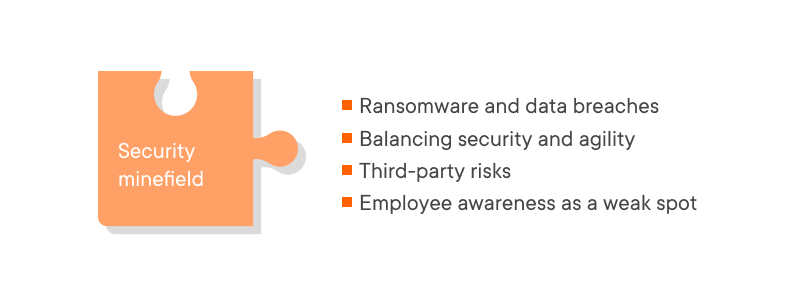
Unsecured systems are a ticking time bomb for your enterprise. The idea of hackers snooping in your systems is terrifying. But the reality? Much scarier.
Latest research shows us these numbers:
- On average, hackers spend nine weeks inside a company’s systems before being detected.
- Ransomware attacks (where cybercriminals keep your data until you pay up) affected 7 out of 8 businesses in 2023 alone.
- In 2023, the average cost a company paid due to a data breach skyrocketed to $4.45 million globally. That’s a 15% increase in just three years.
Even worse is the damage hackers can cause while in your systems, which is:
- leaks of confidential data
- lost competitive edge
- hurt stock price
- public humiliation
- lost productivity
Add in business shutdowns and shattered customer trust which takes years to rebuild (if at all)… yeah, it’s enough to keep you up at night. As one FinTech business leader told us during a discovery call:
“It’s terrifying how much risk we carry. Our customer data is precious, but every new system or integration seems to open another vulnerability. I’m always half-expecting a major breach that’ll end up in the news. We need to act before it’s too late.”
– A CIO of a FinTech enterprise with 200 employees burdened by overwhelming risk and the fear of a data breach
The good news? You can significantly reduce the chances of your systems hacked with strong data security practices and an overall solid data governance framework.
But for now, take a moment to assess your enterprise security posture.
Quick security self-assessment
This quick-fire checklist reveals your security status. The more “yes” answers, the stronger your defenses.
1. Do we have complete visibility into who has access to sensitive data and for what purpose?
2. Is our plan for handling security incidents clear, current, and frequently practiced?
3. Are our employees trained to spot common security threats like phishing?
4. Do we have a system to fix vulnerabilities and keep our security measures up to date?
5. Have we checked data management practices of our vendors and partners to reduce risks from outside our company?
Alright, counted your “yes” answers yet? Fantastic — write that number down and let’s keep going. Time to explore another area where your enterprise might face challenges and see how many “yeses” you can get there.
Challenge #2: Siloed data that makes you feel like you’re constantly missing the target
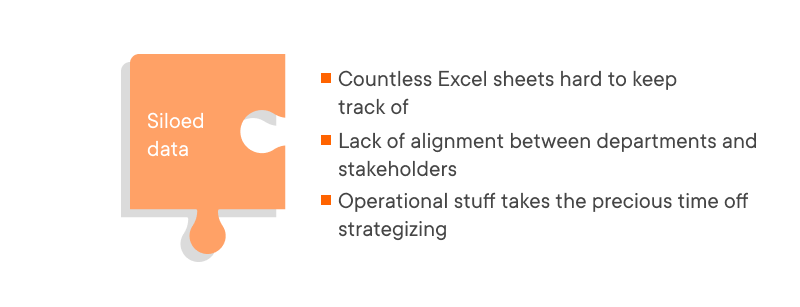
Every hour your team wrestles with spreadsheets or local files is an hour your competitor uses to outsmart you. Partnering with a big data services company can help break down data silos and ensure that valuable data flows seamlessly across departments, improving alignment and efficiency.
In fact, relying on spreadsheets for complex processes can block even the most tech-savvy companies. A prime example is Formula 1. They managed the design and construction of their race cars with a gigantic Excel sheet containing 20,000 car parts. The spreadsheet became “impossible to navigate and impossible to update,” stalling development progress and showing us the limitations of conventional solutions like Excel in meeting modern business demands.
While spreadsheets may never go out of style, they can lead to data silos that spread like invisible walls within your company. Departments collect crucial data in separate sheets, but it doesn’t flow freely. Take this example from one of our clients:
“My departments work hard, but information gets trapped. It’s a constant battle trying to keep them all straight, never knowing if the information you’re looking at is current or if someone else has made changes that you don’t know about. This lack of alignment makes us feel like we’re constantly missing the target. ”
– A frustrated COO of a rapidly growing online bank, struggling to sync customer data across multiple spreadsheets for accurate and timely account updates
This experience highlights the hidden costs of data silos, as valuable data wastes away in isolated files and systems:
- Missed opportunities. Market trends and customer needs become blind spots, leaving your competitors to steal the game.
- Decisions made in the dark. Conflicting information creates confusion, preventing you from reacting quickly and sensibly.
- Wasted time and brainpower. Your best people spend hours hunting for the “right” version of the truth. That’s money flushed down the drain. They should be analyzing, strategizing, and innovating instead of acting as Excel detectives, right?
Ready to identify whether there are cracks in your enterprise’s data consistency? Answer these quick questions.
Quick data consistency self-assessment
The more “yes” answers, the more consistent your enterprise data is.
- Can employees from different teams quickly locate and use the data they require?
- Are you confident that everyone is using the same, current set of accurate data?
- Do your analytics and reports paint a consistent picture across various departments?
- Do you spend minimal time manually searching for and preparing data, focusing more on strategic initiatives?
- Is your data well-structured and formatted consistently across different systems and sources?
Count your “yes” answers if any and add them to your earlier security check. Now let’s move to another crucial area that could be giving you a headache.
Challenge #3: Hidden non-compliance costs, where fines are just the start
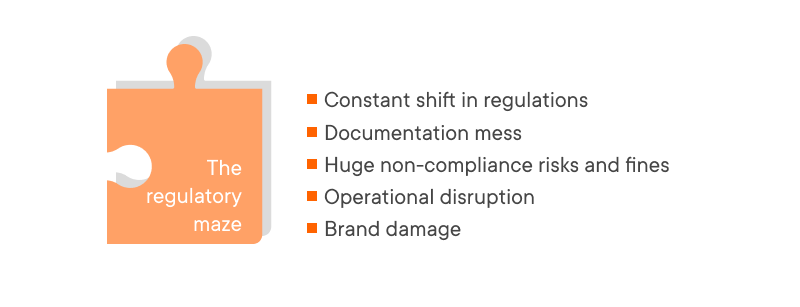
Compliance with regulations and industry standards might seem like a distant problem, but a single misstep can trigger a public relations (PR) nightmare, hefty fines, and possible jail time, even.
Complying with well-known laws like GDPR, CCPA, and HIPAA may be common knowledge for most (though no less complicated). However, new regulations constantly appear. For instance, in France, corporate directors can face jail time and fines up to $81,400 if they fail to comply with the new sustainability reporting requirements, which took effect in 2024.
Trying to keep up with constant regulatory updates, business executives often feel like a “hamster in a wheel”:
“Change is the only constant. Keeping up to constantly shifting regulations and industry standards is exhausting, and one slip-up can be disastrous. Half the time, I’m not even sure if the cool new analytics tools we’re considering will be compliant. It feels like the rules of the game keep changing faster than we can adapt. And it results in a documentation mess and disrupted operations.”
– A weary CFO in healthcare, struggling to navigate the ever-shifting regulatory landscape while keeping the company’s financial operations running smoothly
How to find a balance between compliance and innovation in FinTech
Read the articleIs staying compliant a big pain for your enterprise? Take this self-assessment to make sure.
Quick compliance self-assessment
The more “yes” answers, the stronger your compliance posture is.
1. If a customer asks for all the personal data you have about them, can you easily find and provide it? (e.g., as the GDPR requires)
2. Do you have clear rules and records for financial transactions to ensure your financial reports are correct?
3. Do you know and follow all the special rules and licensing needs for your industry? (Like HIPAA rules for healthcare)
4. Do you have set time periods for keeping different kinds of business records, and do you safely get rid of them when that time is up?
5. When you work with outside vendors, do your contracts include rules about protecting data and a process for auditing their compliance?
We’ve covered three key areas of challenges so far. Let’s tally up your “yes” scores one more time, focusing now on data quality — a potential roadblock for many businesses.
Challenge #4: Poor data quality that could steer you in the wrong direction
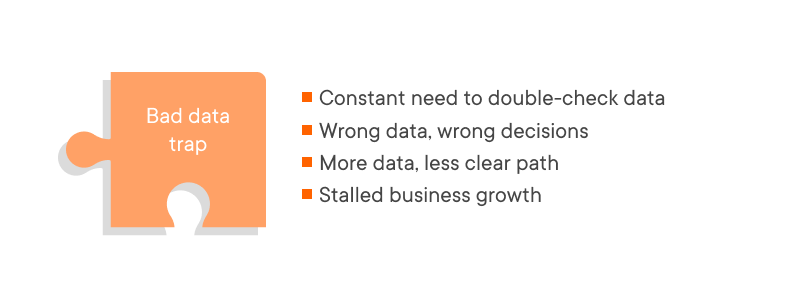
All the fancy analytics tools you invest in become useless if the data itself is of poor quality. You can end up getting misleading insights that steer you completely wrong.
The other major risks of poor data quality?
- Lost revenue. Inaccurate customer data means you’ll miss out on sales or waste marketing efforts on the wrong people.
- Costly mistakes. Even a tiny typo can cost millions. In one case, an employee’s Excel error led to a company refunding $10.47 million instead of the intended $100. Ouch.
- Inefficient operations. Bad data leads to double the work, errors in reports, and delays that chew up both time and money.
- Missed opportunities. Can’t trust the numbers? Can’t make informed choices. Bad data leads to bad investments.
- Stalled growth. Artificial intelligence (AI) became a key trend for boosting operations, but it needs accurate, consistent, reliable data to spot patterns and make smart predictions. That’s why companies often complement data governance efforts with advanced data science services to extract actionable insights and drive innovation from clean, trustworthy data.
Still, the most common data quality issue we hear businesses mention is their inability to see the bigger picture and grow:
“Outdated info, duplicates, inaccuracies. It’s like a swamp of useless data that makes insights impossible. We have tons of numbers, but no real understanding of the “why” behind them.”
– A Head of Business Development at a global retail company, unable to identify emerging market trends due to inconsistent sales data across regions
To find out whether your enterprise risks poor data quality, take a look at the questions below.
Quick data quality self-assessment
The more “yes” answers, the more strong your data quality practices are:
1. Do you often clean up your data, make sure it’s correct, and look for any copies or inconsistencies?
2. When someone enters data wrong, is it usually caught and fixed?
3. Is it clear who is in charge of making sure the data is of good quality?
4. Can you easily see the changes made to data over time?
5. Do you teach employees about how to keep data quality high?
6. Do you regularly check and share how much bad data costs the company (like when it messes up marketing or causes operational mistakes)?
7. Do you keep records of where your data comes from and regularly check if those sources are trustworthy?
Checking your “yes” score
Let’s take a look at your total “yes” count. If you have 22, congrats — your enterprise’s in excellent shape when it comes to effectively managing data. But even with a perfect score, there’s always room for optimization to avoid future risks. And we discuss a solution for that next.
Meanwhile, if you have even a single “no” answer, then you’ll definitely want to keep reading.
Connecting the pieces to solve the data puzzle
The solution we’re about to discuss is the key to solving your data challenges puzzle. Whether you’re struggling with scattered data sources, compliance issues, data inaccuracies, or security concerns, this solution can help you:
- gain a clear, comprehensive view of your business data
- avoid future risks related to data management
- make confident, data-driven decisions instead of relying on guesswork
It all starts with building a solid foundation where you create a data governance strategy. Let’s explore what establishing this data foundation means.
Where all puzzle pieces come together: Address these four issues with a data governance framework
Data governance may sound like another buzzword, but it’s the strategic solution to the problems we’ve discussed. Disconnected systems, conflicting data, and compliance headaches aren’t isolated issues. They indicate a lack of structure that prevents you from effectively managing data from start to finish.
Proper data governance transforms these fragmented challenges (scattered puzzle pieces) into a unified, compliant, secure system for consistently managing high-quality data (a complete puzzle):
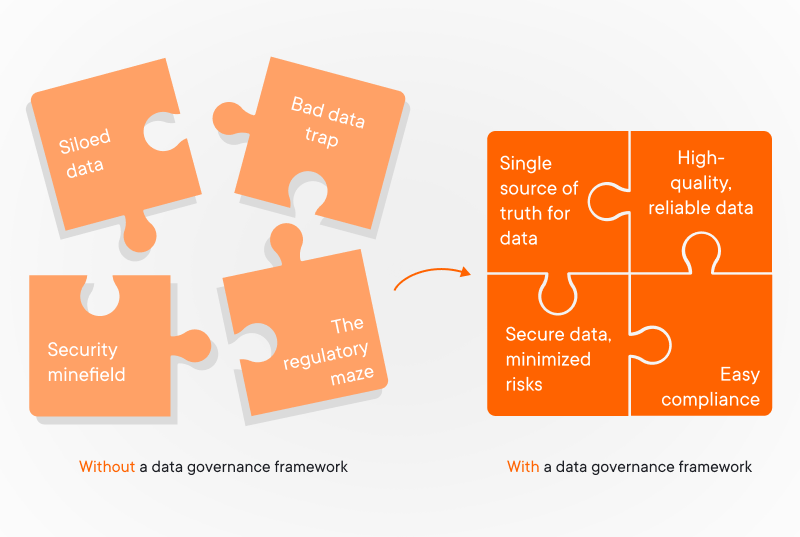
Arranging these puzzle pieces doesn’t only help organize your data. It provides a clearer view of your entire enterprise, highlighting areas for improvement, potential problems, and hidden opportunities.
We understand the hesitation:
- Will data governance become another time-consuming, costly initiative with no clear return on investment (ROI)?
- Will it just create more rules and blockers, slowing your teams down instead of empowering them?
- You may have invested lots in data tools already, isn’t that enough?
- While data governance might help you achieve that fancy “data-driven” status, the idea of implementing it seems daunting. Where do you even begin?
The truth is, not implementing data governance is the greater risk. Every day you operate with fragmented data, you’re missing out on:
- faster, more confident decisions
- less operational costs
- decreased compliance fines and reputational damage
In the following section, we’ll simplify data governance alongside Yalantis’ top data expert — no jargon or buzzwords.
In the meantime, feel free to talk through these concerns with our consultants right away:
What is a data governance framework and why it’s key for modern enterprises to thrive: Yalantis expert answers your burning questions
To guide you through the essentials of a data governance framework, we’ve sought the expertise of Andrii Panchenko, Yalantis’ Lead of business intelligence (BI) and data management. With over 6 years of experience in data and BI, Andrii plays a pivotal role in Yalantis’ data projects and is here to help you navigate the main questions you might have.
Q1: What is data governance? An approach to effectively manage your data, not just another buzzword
Data governance establishes a common language for data throughout the company.
It’s a comprehensive approach that makes sure your data is consistent, trustworthy, and used properly across all departments. Its main goals are to:
- treat data as a valuable company asset
- manage data effectively throughout its lifecycle
- make data use simpler
- reduce risks of data misuse
Andrii explains data governance using a simple analogy:
“No data governance in your organization is similar to leading an unhealthy lifestyle. A data expert’s like a doctor for your organization, overseeing operations with data. By putting good data governance policies and practices in place, they help keep your organization’s data healthy, catch problems early, and make sure all the parts of your system are working together to get you where you want to go.”
– Andrii Panchenko, Lead of BI and data management at Yalantis
Q2: What is a data governance framework example?
An effective enterprise data governance framework provides a set of rules, processes, and tools for making decisions about and with data. It helps ensure that your data is healthy and can withstand any threats. While there are many data governance frameworks examples online, they all share a common goal: ensuring data is accurate, consistent, and secure.
The following visual represents the critical data health components that Yalantis experts focus on in all data governance projects. This framework brings together key puzzle pieces, creating a complete and cohesive data system that’s essential for effective data governance:
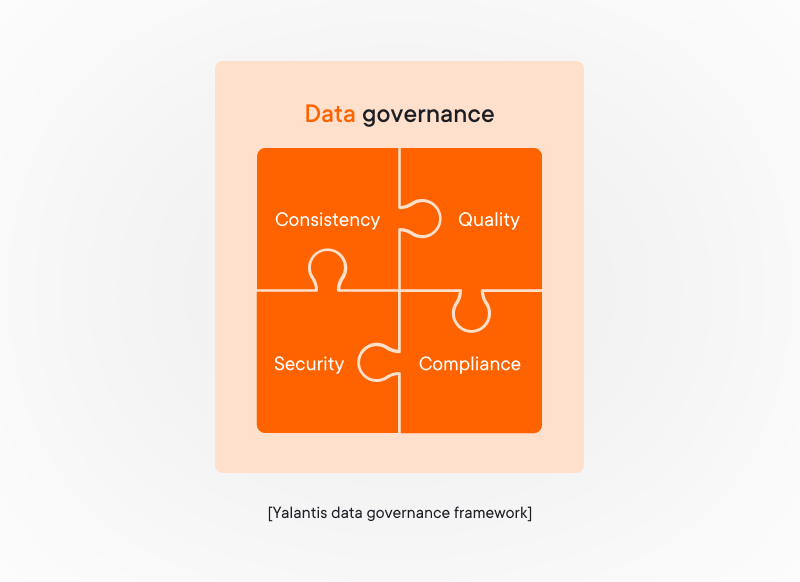
What are the components of data governance? A detailed look
Let’s further unpack these key data governance components within this framework:
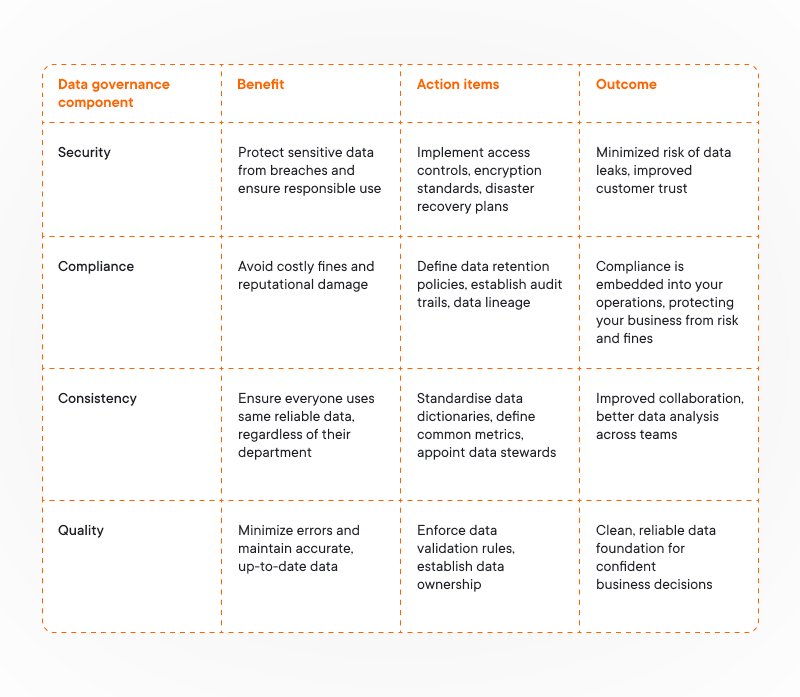
Q3: Why should modern enterprises pay attention to data governance initiatives?
Just as a person can survive without a healthy lifestyle, enterprises can continue operating without data governance initiatives.
But merely surviving won’t allow your business to thrive and overcome the challenges that come your way. A lack of a “healthy lifestyle” for your data makes it difficult to identify areas for improvement and risks everything falling apart at once when a threat hits.
Modern enterprises with lots of data must pay attention to data governance to:
- make strategic decisions
- effectively address data issues
- prevent data misuse
By doing so, they take control of their own data assets and make sure they’re healthy. This helps the business flourish in the face of challenges.
Q4: What’s the main ROI data governance can bring?
Here are the ROI results businesses achieve from their data governance initiatives, based on Yalantis projects:
- Real-time control over data to quickly make sound decisions and confidently adapt to changing market conditions.
- User base increase due to targeted campaigns and proactive customer engagement with accurate data.
- Accurate data in reporting and analysis, constantly checked for errors and inconsistencies. This ensures confidence in the data used to make crucial business decisions.
- Actionable insights to improve product features, customer experience, and identify untapped revenue streams with hidden patterns, trends, and correlations within enterprise data.
- Confident experimentation and innovation by testing new ideas and strategies (e.g., experiment with different pricing models) using real data in a secure, isolated environment without affecting your live systems.
Q5: Can you implement data governance without disrupting your business?
You might think that a data governance project will become a major distraction and require hiring a huge team or shifting your existing employees away from their primary responsibilities.
Andrii eases these concerns:
“You don’t need a big team to get your data in order. One or two skilled data specialists can show you the way. They’ll start with small changes that make a real difference, without disrupting your daily work. The key is keeping everyone in the loop and tackling the biggest issues first. In the end, the right data governance setup will make life easier for the whole team.”
– Andrii Panchenko, Lead of BI and data management at Yalantis
Q6: How long will implementing data governance take?
The exact timeframe will vary depending on how complex your current systems and business goals are. But you can get an estimate based on how data governance projects typically unfold at Yalantis:
- Stage 1: Data governance assessment and foundation (6-8 weeks). Think of this as a diagnostic exam for your data. We work with clients to understand their existing systems, identify pain points, and create a plan to address them. This includes fixing immediate security holes, improving data quality, and putting basic monitoring in place to quickly spot problems.
- Stage 2: Standardization and optimization (1-3 weeks). Once we’ve identified the most vital issues, we establish clear rules for how to handle data and make data search easier.
- Stage 3: Ongoing growth and innovation. We work with clients to ensure their data governance infrastructure supports new projects. They become equipped to use advanced technologies like artificial intelligence (AI) to forecast trends, identify potential fraud, and more.
Keep in mind that implementing data governance is an ongoing process that shifts the culture of data use at your enterprise. Like with healthy habits — you see results over time, and the benefits increase when you stay consistent. As Andrii explains:
“Data governance isn’t a one-and-done project. It’s about transforming how your business uses data. By starting with clear priorities and achievable milestones, you can quickly see positive results while setting the stage for long-term success.”
– Andrii Panchenko, Lead of BI and data management at Yalantis
Okay, done with theory now. Ready to see how data governance delivers real-world results?
Next, we explore two case studies where Yalantis:
- helped a rapidly growing online bank tackle data chaos with data governance, which increased their user base and cut operational losses from fraud in half
- applied data governance principles to streamline our own internal operations
Case study #1. How a data governance framework helped a fast-growing online bank boost efficiency
Imagine experiencing phenomenal growth, attracting thousands of new customers every month. But instead of celebrating, you’re dealing with a risk of inaccurate reports, security vulnerabilities, and a constant struggle to keep up with your ever-growing data.
This was the reality for our client, a leading US online bank, as their success story collided with a data management nightmare.
To solve these challenges, it’s key to build a data foundation that can stand the test of time:
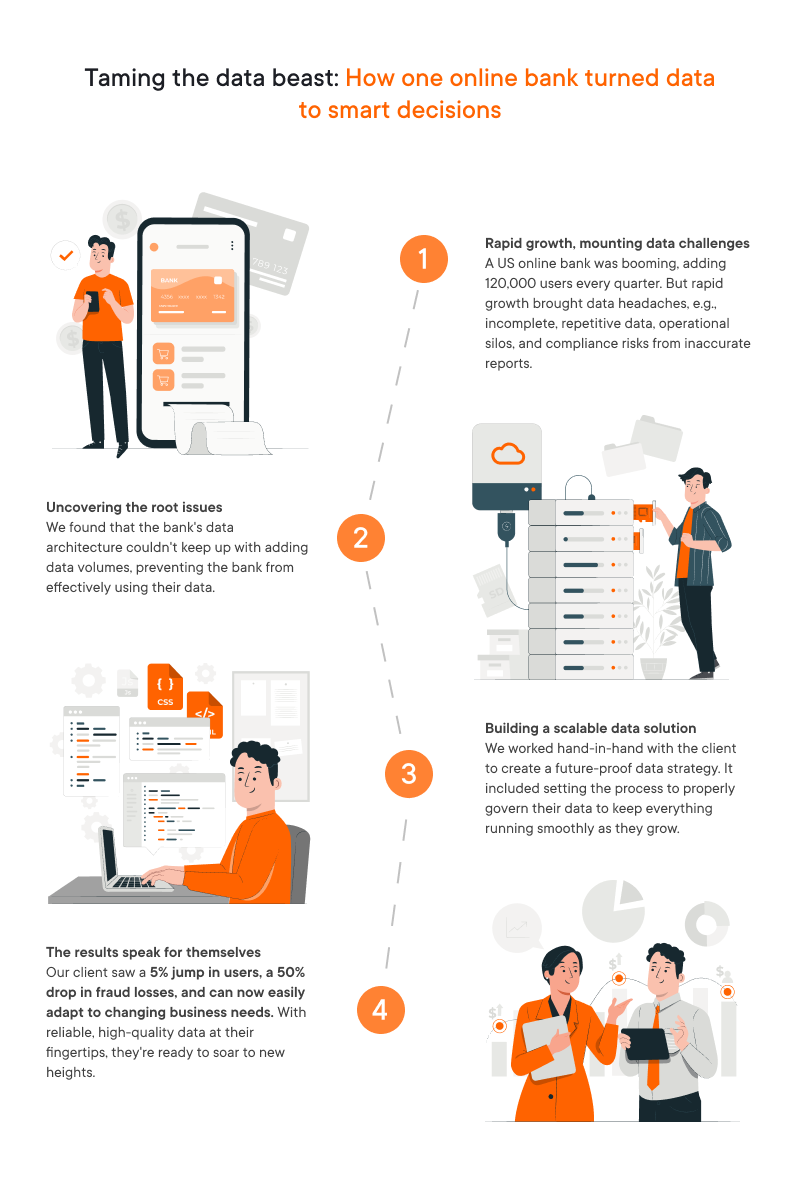
While online banking might seem like a unique case, many businesses face similar challenges when it comes to managing vast amounts of data, often due to resource constraints. We know there’s no universal solution. That’s why we collaborate closely with clients, tailoring our data governance approach and making the most of their existing resources.
Discover the strategy to master data that fueled this online bank’s success
Explore the case studyBut we don’t just preach this philosophy; we live it. In fact, we used these same principles to optimize our own internal operations.
Case study #2. Walking the talk: How Yalantis applied data governance framework to improve our own operations
Scattered data, manual reporting, and siloed information prevented Yalantis’ management from seeing the bigger picture.
“The goal was to scale effectively, rapidly processing the growing volume of data and activity that comes with expansion, while also ensuring seamless interaction between technology and people. We began our transformation by focusing on data governance — the foundation for everything — and how data is structured, managed, and used within our business.”
– Denys Doronin, CTO at Yalantis
The solution wasn’t just about fixing technical issues, but strategic. We needed a future-proof foundation for our data. Our internal team built a centralized enterprise resource planning (ERP) system with business intelligence (BI) capabilities, utilizing business intelligence services and solutions to enhance data analysis and decision-making. They implemented data governance principles to ensure data quality, consistency, and security:
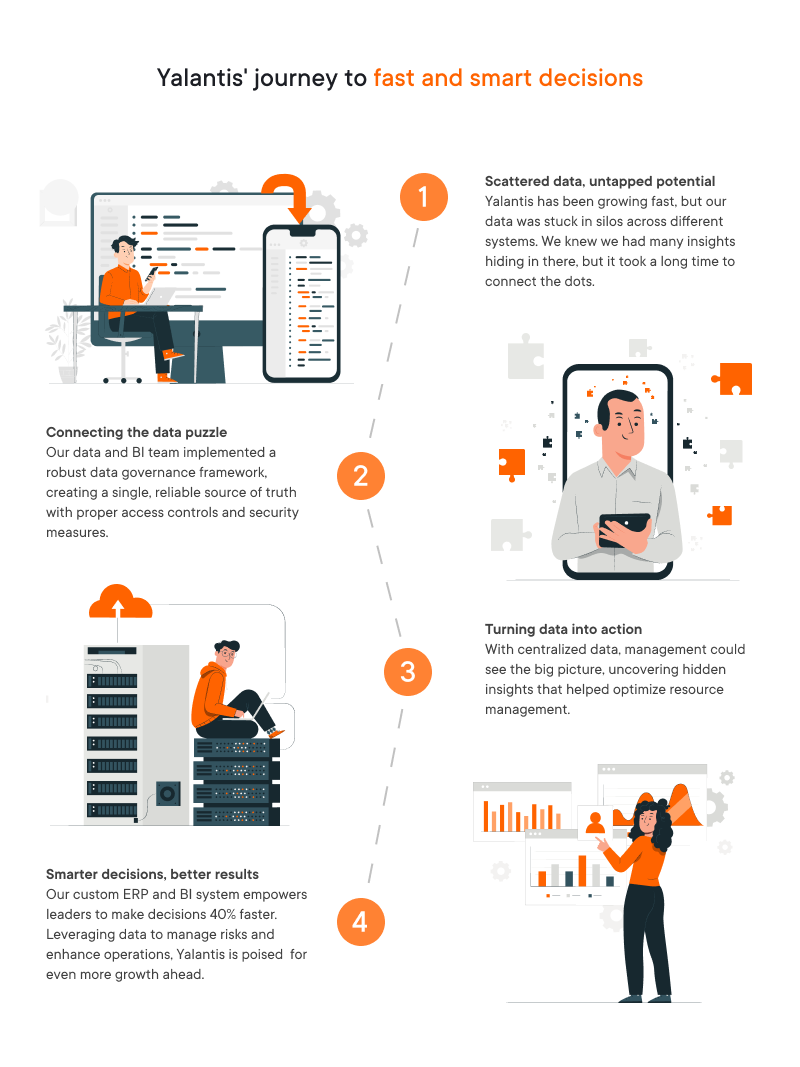
See how Yalantis turned its data governance challenges into strategic advantages
Explore the case studyIf the idea of your own data governance journey sounds intriguing, let’s see the key steps to get you started.
Building your solid data governance structure: Stop guessing, start knowing
Yalantis data experts recommended these 5 steps your data team can take to boost your data governance:
- Perform data discovery. Identify critical data elements, where they’re stored, and their sensitivity level. This reveals potential vulnerabilities and data quality issues.
- Identify data owners and apppoint data stewards. Assign clear accountability for each data asset. This ensures consistency, prevents duplication, and empowers employees to maintain data accuracy.
- Set basic data standards. Create simple rules for data definitions, formats, naming conventions, and update frequency. This makes it easier to integrate and analyze data across the company.
- Start tracking key metrics. Select a monitoring method (reporting/key performance indicators/life cycle/errors/indicators and anomalies). It’ll help you spot issues early and track progress.
- Plan for the long-term. Understand that effective data governance is an ongoing process, not a quick fix. Begin budgeting and planning for comprehensive data governance solutions.
Implement your data governance program faster with experienced support — and less stress
Building a strong data governance strategy requires time, resources, and expertise. We know that turning data chaos into strategic clarity can seem overwhelming. You might not have a crystal-clear vision of your data governance efforts yet, and that’s okay. Our data consultants are here to guide you through a quick consultation, where they’ll:
- listen and assess. You’ll begin by understanding specific challenges of your business, current data governance processes, and desired outcomes.
- identify key issues. Together, you’ll pinpoint the root causes of your data problems, whether it’s compliance gaps, poor quality, or disorganized data.
- develop a data governance roadmap. You’ll create a clear, actionable roadmap tailored to your needs and budget, outlining steps, timelines, best practices, and expected results.
If you’re open to it, Yalantis can be more than just your consultant. We can be your implementation partner and data governance team, bringing your (even blurry) data governance vision to life with technology solutions, data analytics services and solutions, and ongoing support.
Let’s get you out of this maze and find your way to healthy data, shall we?
Gain clarity and confidence in your data
Book a strategic consultation with our data experts to map out your next steps with data governance.
Start my journey to high-quality, secure dataFAQ
Are there specific industries where data governance is particularly crucial?
Industries that deal with sensitive data (healthcare, finance, legal) have the most to gain with data governance due to the many compliance requirements they have to navigate.
Yet, any industry that relies on data-driven decisions can benefit from stronger data governance.
What if we don’t have the resources to implement a full data governance strategy?
Start with a focused assessment to pinpoint your most urgent pain points. Often, addressing a few critical areas delivers immediate value and lays the groundwork for a comprehensive data governance strategy down the line.
We already have some data tools in place. Do we need data governance?
Tools are powerful but rely on a strong foundation. A data governance framework ensures that your tools work together effectively, maximizing their potential and filling any gaps in your data management.
Does following a data governance framework block innovation?
Done correctly, data governance actually helps innovation. With clear and trustworthy data, teams can confidently experiment and test new ideas, minimizing risks and speeding up progress.
Rate this article
4.9/5.0
based on 56 reviews



